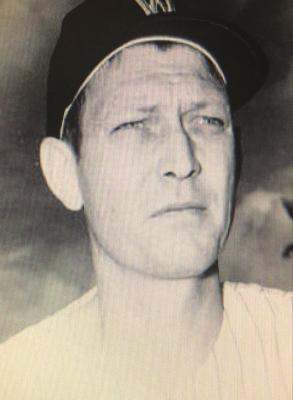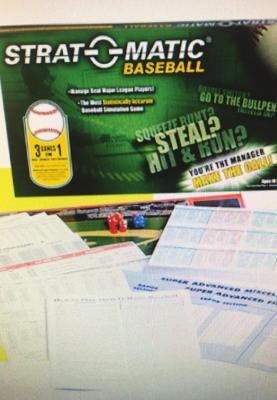Strat-O-Matic was early version of fantasy sports
With more time on my hands than what I am accustomed to, I read lots of stuff on my phone. I came across an article, which try as I might now, can’t find again.
Anyway, it was a story about two adult friends who have gotten together four of five times a year in the past to play Strat-O-Matic Baseball. Lately. with the coronavirus crisis, they have played the game daily. I didn’t remember whether they were playing over the phone or what, but the idea that caught my attention was they were playing Strat-O- Matic. If you aren’t familiar with the game, let me just say that when I first became acquainted with it, it involved a board, dice and cards for every player on every Major League Baseball team. I am not sure of all the more recent developments and modifications, but I know that one can play the game with a phone app these days.
I have noted with great interest the volume of participation in fantasy sports. I have friends and colleagues who participate in one fantasy sport or another. I haven’t joined in, but I can say that I have had my own somewhat private version of fantasy sports for years and years.
Strat-O-Matic was an early version of fantasy sports. It first was introduced in 1961 when I was still in high school and I never personally owned a game with that brand name on it. The way it was sold in the early years was through advertisements in major sports publications. I would see the ad and lust in my heart to own one. It was a little pricey for my bank account and it wasn’t until my son turned 12 that anyone that I knew personally ever had one. When he saw an ad in Sports Illustrated and asked for one, I made sure he got it. He spent long hours in his room rolling dice and playing the game.
While I never had a Strat-O-Matic of my own, I had been heavily involved in playing fantasy sports games long before 1961. My parents once gave me a football board game which included a deck of cards and a plastic football moving piece. How it worked was the participants chose a play (run wide, run through the line, pass deep or short pass) and then drew a card. Depending where the plastic football was on the playing board you would see how many yards you gained. For example, if my team had the ball on the opponent’s 30-yard line and I chose short pass, I would turn up a card and it would tell me if the pass was incomplete, or if it was complete, how many yards were gained. I loved that game.
It was designed for two players, but I would operate both teams and pretend that teams were made up of specific players. Each year I would purchase the current Street and Smith College Football yearbook and from it would make up All-Star teams from the various regions. There would be a league made up of teams from the Big 7, Southwestern Conference, Pacific Coast Conference, Big 10, etc. I spent many an hour sitting by my game board playing this game. Often I would pick the All-Star teams from pictures in the magazine. If I didn’t know who to pick, I would choose the most ferocious looking athlete. I think somewhere in my archives (a plastic tub out in the garage) I still have some of those Street and Smith books.
One of my classmates and I had a basketball game that we played. more often than I care to remember. It was of his devising and I don’t remember all the details of how it was played. There was no board, just a pair of dice that he took from a board game that neither of us liked to play. We would make up teams involving our favorite college players and by throwing the dice would determine how these teams were doing. I remember that there wasn’t any rhyme or reason how points were scored. There were games when Wilt Chamberlain, for example, wouldn’t score a point and some very uncoordinated acquaintance of ours from school (who had no idea he was a participant in our game) would score a big bunch.
That friend and I also used to play a baseball game. The game belonged to him and we didn’t play often, but it made me wish for my own game. His game had a spinner and how one would determine what a player at bat did was through the outcome of a spin. There were cards with the names of specific players and I know one of the four teams provided by the makers of the game was the 1927 New York Yankees. As I remember the other three were contemporary teams--New York Yankees, St. Louis Cardinals and Los Angeles Dodgers. I was really interested in the 1927 Yankees. On it there were Babe Ruth and Lou Gehrig of course. I learned that Jumpin’ Joe Dugan, Mark Koenig and Earle Combs were also part of that team. And through my friend’s game, I learned that the top pitchers for the ‘27 Yankees were Waite Hoyt and Urban Shocker.
We used to mix up the teams. For example, my friend was a big St. Louis Cardinals fan and he would always want to be the Cardinals. He would always insist on trading one of his least favorite Cardinal player for Babe Ruth of the 1927 Yankees. I usually played using the more current New York Yankees team. If he got Babe Ruth for his team, I would insist on trading for Gehrig for mine.
Spurred on by the experience playing with my friend, I saved my money and purchased my own baseball game. A different version than his, it was one that was advertised in a comic book I had, the ad found along other ads for worm farms and Charles Atlas body building systems. I didn’t know what I was getting, but once it came in the mail, it served my purpose quite well. As I understand Strat-O-Matic, my game would have been a poor person’s version of it.
I enjoyed playing the game as it was designed to be played. But after awhile I began making my own modifications. I would stack certain teams I liked with good players that I traded from other teams. For example, the Kansas City Athletics, always very bad in reality, were very good in my league. And I would adjust the abilities of certain players I wanted to perform well. One of the most capable shortstops in my league was a player by the name of BIlly Klaus. In real life, Klaus was never more than a parttime player put in the lineup on occasion for his defensive ability. In my league, Klaus played every day for Kansas City and hit over .300 and was a capable power hitter. Don’t ask me why I liked Klaus. He was an obscure player who mostly played for the Boston Red Sox. I would also move franchises. I would move the Milwaukee Braves back to Boston, for example, and the Baltimore Orioles to St. Louis. I guess the latter made sense because I had been a big St. Louis Browns fan as a small youngster. I also moved the Cleveland Indians to Baltimore to make up for the loss of the Orioles.
It was interesting that when my son had his Strat-O-Matic, he would do much of the same thing, stacking his favorite team with great players. He was proud of the fact that the team he chose to manage (with a stacked lineup, of course) would win about every game.
I understand one thing Strat-O_Matic is doing during this current crisis is streaming simulated games that people can watch (for a price I imagine). And the regular version created for the 2020 season is for sale. With no real baseball, it may be the next best thing. But such a deal still wouldn’t entertain me like my version of playing baseball with dice once did.



